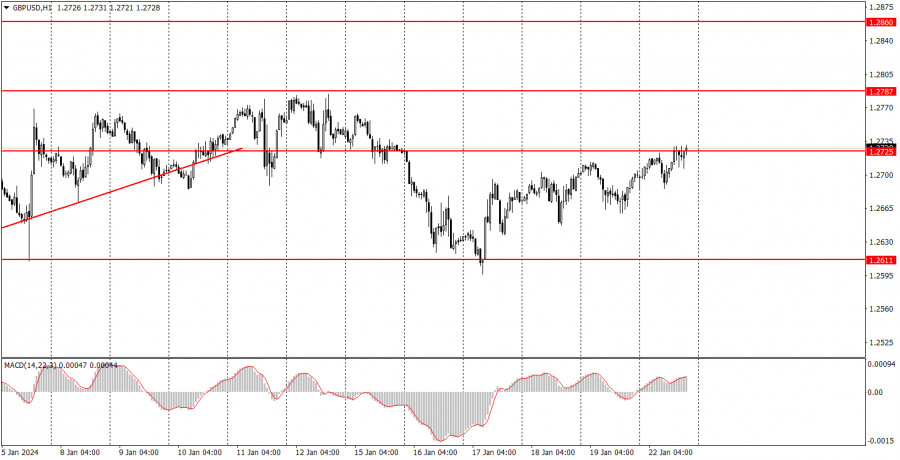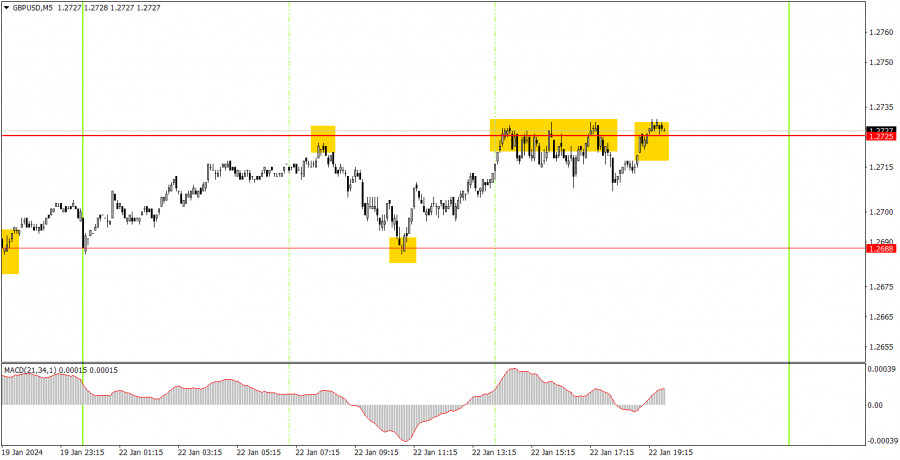

The GBP/USD pair continued to move higher within the sideways channel of 1.2611-1.2787. Since the lower boundary of the channel had been tested last, it was reasonable to assume that the next move would be towards the upper boundary. And that's exactly what happened. However, the movement was quite weak. Volatility was around 50 pips on Friday and about 40 pips on Monday. In general, this also means that the pair did not show any distinct movement. But the pound did not stand still on Friday or Monday, so we did see some movements, although it was quite weak.
By the end of the day, the price had tested the level of 1.2725. We do not believe that a downward reversal is possible around this level, but the pound may not rise to the upper boundary of the sideways channel until it surpasses this mark. We expect a downward movement in the medium term, but we have only observed a flat market for more than a month now. On Monday, there were no interesting events in either the UK or the US, so there is simply nothing to analyze.
GBP/USD on 5M chart
The pair's movements on the 5-minute timeframe were not the best. Nevertheless, a few decent signals were formed. First, the pair bounced off the level of 1.2725 with an error of 2 pips, then it accurately bounced off 1.2688. And eventually returned to 1.2725, where it stayed until the end of the day. Therefore, you could earn about 15 pips for the first short position. It was also the same amount for the second trade. The last bounce from the level of 1.2725 did not bring a profit or loss, as the price moved more sideways than up or down by the end of the day. As a result, it was possible to make a profit of 30 pips, which is quite good given the overall volatility of 40 pips.
Trading tips on Tuesday:On the hourly chart, GBP/USD is still trading within the sideways channel of 1.2611-1.2787. The price rebounded from the 1.2611 level five times, and after the last bounce, a new uptrend has started within the flat, which is clearly visible on the 4-hour timeframe. Now the price can continue to gradually rise towards the upper boundary of the sideways channel.
On Tuesday, there's a good chance that the British pound will likely remain within the range. There will be no important fundamental or economic events in either the US or the UK, so it will be quite difficult to expect strong growth or decline. The price is almost in the middle of the channel, so there's a small chance of breaking out of it.
The key levels on the 5M chart are 1.2270, 1.2310, 1.2372-1.2387, 1.2457, 1.2502, 1.2544, 1.2605-1.2611, 1.2688, 1.2725, 1.2787-1.2791, 1.2848-1.2860, 1.2913, 1.2981-1.2993. On Tuesday, there are no important events lined up in the UK or the US. Therefore, volatility will likely remain low, and we will probably witness weak movements.
Basic trading rules:1) Signal strength is determined by the time taken for its formation (either a bounce or level breach). A shorter formation time indicates a stronger signal.
2) If two or more trades around a certain level are initiated based on false signals, subsequent signals from that level should be disregarded.
3) In a flat market, any currency pair can produce multiple false signals or none at all. In any case, the flat trend is not the best condition for trading.
4) Trading activities are confined between the onset of the European session and mid-way through the U.S. session, after which all open trades should be manually closed.
5) On the 30-minute timeframe, trades based on MACD signals are only advisable amidst substantial volatility and an established trend, confirmed either by a trendline or trend channel.
6) If two levels lie closely together (ranging from 5 to 15 pips apart), they should be considered as a support or resistance zone.
How to read charts:Support and Resistance price levels can serve as targets when buying or selling. You can place Take Profit levels near them.
Red lines represent channels or trend lines, depicting the current market trend and indicating the preferable trading direction.
The MACD(14,22,3) indicator, encompassing both the histogram and signal line, acts as an auxiliary tool and can also be used as a signal source.
Significant speeches and reports (always noted in the news calendar) can profoundly influence the price dynamics. Hence, trading during their release calls for heightened caution. It may be reasonable to exit the market to prevent abrupt price reversals against the prevailing trend.
Beginners should always remember that not every trade will yield profit. Establishing a clear strategy coupled with sound money management is the cornerstone of sustained trading success.